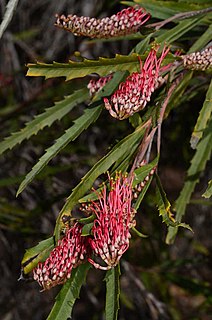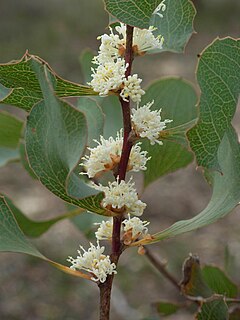
Grevillea longifolia, commonly known as fern-leaf spider flower, is a species of flowering plant in the family Proteaceae and is endemic to the Sydney Basin in New South Wales. It is an erect to spreading shrub with narrowly egg-shaped to almost linear leaves, and toothbrush-like groups of pinkish-fawn flowers with a pink to red style. It is fairly readily grown in gardens.

Banksia subg. Isostylis is a subgenus of Banksia. It contains three closely related species, all of which occur only in Southwest Western Australia. Members of subgenus Isostylis have dome-shaped flower heads that are superficially similar to those of B. ser. Dryandra, but structurally more like reduced versions of the "flower spikes" characteristic of most other Banksia taxa.

Banksia arctotidis is a species of prostrate shrub that is endemic to the southwest of Western Australia. It has leaves that are pinnately divided to the midrib, cream-coloured flowers and hairy, egg-shaped fruit.
Banksia biterax is a species of dense shrub that is endemic to Western Australia. It has hairy stems, deeply serrated leaves and spikes of up to 200 pale to dark brown flowers.

Banksia bipinnatifida is a species of shrub that is endemic to Western Australia. It is a prostrate shrub with a lignotuber, an underground stem, only a few divided leaves, large cream-coloured to pale yellow flowers and large fruit.

Banksia calophylla is a species of shrub that is endemic to Western Australia. It has a fire-tolerant, underground stem, pinnatifid leaves that have woolly hairs on the lower surface and heads of thirty to forty-five yellowish brown flowers surrounded by hairy bracts.
Banksia concinna is a species of shrub that is endemic to Western Australia. It has elliptical leaves with between five and twenty triangular teeth on each side, hairy heads of yellow flowers and hairy, egg-shaped fruit.

Banksia cynaroides is a species of shrub that is endemic to Western Australia. It has crowded, linear, pinnatifid leaves, white and dull golden yellow flowers and few follicles in each head.
Banksia foliolata is a species of shrub that is endemic to Western Australia. It has hairy stems, pinnatifid leaves, heads of about sixty cream-coloured and maroon flowers and oblong to elliptical follicles. It grows on rocky slopes in dense shrubland in the Stirling Range National Park.

Banksia fraseri is a species of shrub that is endemic to Western Australia. It has hairy stems, broadly linear pinnatisect leaves with between four and eighteen sharply-pointed lobes on each side, between eighty and one hundred pink to cream-coloured flowers and wege-shaped follicles.

Banksia obtusa, commonly known as shining honeypot, is a species of shrub that is endemic to the south-west of Western Australia. It has underground stems, linear pinnatifid leaves with triangular lobes on each side, cream-coloured to yellow flowers in heads of up to seventy, surrounded by dark reddish bracts and egg-shaped follicles.
Banksia plumosa is a species of shrub that is endemic to Western Australia. It has hairy stems, broadly linear pinnatifid to pinnatipartite leaves with triangular lobes, creamy-yellow flowers in heads of up to eighty, and egg-shaped follicles.

Banksia serra, commonly known as serrate-leaved dryandra, is a species of shrub that is endemic to Western Australia. It has broadly linear, serrated leaves, pale yellow flowers in heads of about thirty and egg-shaped follicles.

Banksia squarrosa, commonly known as pingle, is a species of prickly shrub that is endemic to Western Australia. It has linear to narrow lance-shaped leaves with up to ten sharply-pointed teeth on each side, yellow flowers in heads of about sixty and later, up to seven oblong to egg-shaped follicles in each head.
Dryandra subg. Diplophragma is an obsolete subgenus within the former genus Dryandra. It was first published by Robert Brown in 1830, but was discarded by George Bentham in 1870. It was reinstated with a new circumscription by Alex George in 1996, but was ultimately discarded again in 2007 when Austin Mast and Kevin Thiele sunk Dryandra into Banksia.
Robert Brown's taxonomic arrangement of Dryandra was the first arrangement of what is now Banksia ser. Dryandra. His initial arrangement was published in 1810, and a further arrangement, including an infrageneric classification, followed in 1830. Aspects of Brown's arrangements can be recognised in the later arrangements of George Bentham and Alex George.

Dryandra subg. Hemiclidia is an obsolete plant taxon that encompassed material that is now included in Banksia. Published at genus rank as Hemiclidia by Robert Brown in 1830, it was set aside by George Bentham in 1870, but reinstated at subgenus rank by Alex George in 1996. In 2007, all Dryandra species were transferred into Banksia at series rank, and the infrageneric Dryandra taxa, including D. subg. Hemiclidia, were set aside.

Hakea cristata, commonly known as the snail hakea, is a shrub in the family Proteaceae native to Western Australia. An ornamental prickly shrub with attractive foliage and creamy white rounded flowers appearing in profusion in the winter months.

Stenocarpus cunninghamii, commonly known as little wheel bush, is a species of flowering plant in the family Proteaceae and is endemic to northern Australia. It is a shrub or small tree with simple, narrow elliptic or lance-shaped adult leaves, groups of pale yellow or white flowers and woody, linear follicles.

Grevillea anethifolia, commonly known as spiny cream spider flower, is a species of flowering plant in the family Proteaceae and is endemic to continental Australia. It is an erect shrub with hairy branchlets, lobed leaves, the lobes sharply pointed, and white to pale yellow or cream-coloured flowers.














